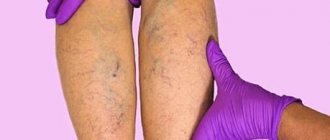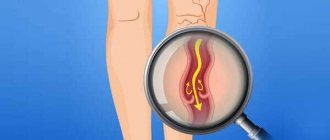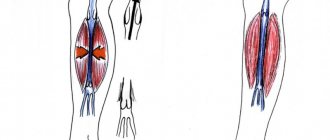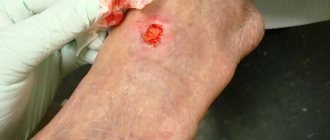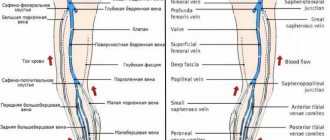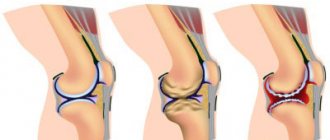Varicose veins on the legs, or simply varicose veins of the legs, are not only an aesthetic, but a serious physical problem for humans in modern society, which directly threatens life and health in the absence of proper therapy. Therefore, phlebology specialists. Vascular surgeons strongly advise that if you have dilated vessels, you should contact a medical facility. There are phlebologists at the MED CITY clinic in the center of Kyiv. With them we will try to understand all the modern methods of treating varicose veins that exist today [1].
According to the latest statistics, in the world more than 75% of women and about 60% of men in developed regions suffer from varicose veins. This means that the pathology of the vascular system has become global and is subject to detailed information to the general population in order to prevent its occurrence in the future.
How do varicose veins occur on the legs?
To have an idea of the reasons for the appearance of dilated veins, let us recall the structure of blood vessels in the lower extremities of a person. The blood in the veins, with each heartbeat, overcomes the laws of physics, moves from bottom to top. This process involves special venous valves that prevent blood from going down. It is the dysfunction of the valves of the venous vessels that provokes the occurrence and further development of varicose veins. There is an inevitable dilation of blood vessels, loss of their tone and an unpleasant aesthetic appearance of the limbs (especially on the legs).
Varicose veins of the lower extremities - how to treat with ointments
In the pharmacy you can find a huge number of ointments for varicose veins of the lower extremities. They are based on substances that improve tissue trophism, relieve swelling and strengthen the vascular wall. Varicose veins of the lower extremities, photos and reviews of ointments are available on the drug pages on the Internet.
Treatment of varicose veins with ointments and gels
In the early stages of the development of the disease, the use of various ointments can improve the condition of the venous system and slow down the progression of the disease, but it will not be possible to completely defeat varicose veins of the lower extremities. The results will be available only after visiting a doctor.
There are several stages of varicose veins, each of which has its own characteristics.
In the first stage, a person does not feel any symptoms, except for minor discomfort in the legs, as well as a feeling of “heavy legs”. Depending on the individual characteristics of the body, fatigue in the legs can occur even after running or walking short distances [2].
The second stage, subcompensatory, is characterized by an increase in the characteristics of the first symptoms, as well as cramps, severe swelling, a tingling sensation or aching discomfort.
At the third stage, the skin on the legs, due to further expansion and deformation of the venous vessels, undergoes irreversible changes, namely:
- compaction of all superficial layers of the skin, as well as the dermis;
- formation of hyperpigmentation on the skin;
- constant swelling, regardless of the time of day;
- the occurrence of trophic ulcers due to an increased level of skin trauma.
Attention! When you reach the third, decompensation stage of varicose veins, you need to consult a doctor to prevent such serious complications of the disease as thromboembolism or thrombophlebitis.
The sooner you come to a qualified specialist in vascular pathologies, the better the prognosis for recovery will be. Depending on the stage of the disease, you must strictly follow all the recommendations of the phlebologist, as well as make adjustments to your lifestyle and give up bad habits.
Cure varicose veins
Varicose veins of the lower extremities - treatment with radiofrequency
How to remove varicose veins of the lower extremities? RFA treatment is of particular interest to patients. Why do many people dream of eliminating varicose veins of the lower extremities and prefer RFO treatment?
Radiofrequency ablation (RFA) is an operation that can be performed on an outpatient basis if you want to forget varicose veins of the lower extremities. RFA treatment in Moscow uses radio frequency, which is used to “seal” a vein and remove varicose veins of the lower extremities. RFO treatment in Moscow is fast and effective.
Diagnosis of varicose veins in Kyiv
To determine the stage of development of varicose veins, a primary consultation with a phlebologist is first carried out, during which a face-to-face examination of the patient is carried out, an anamnesis is taken, a survey is carried out regarding the presence of a similar pathology in close relatives, as well as palpation of skin lesions with varicose veins found on the legs. To make an accurate diagnosis, the doctor must offer the patient a special ultrasound examination, called duplex scanning of the vessels of the lower extremities with mapping of blood flow in them. This is a painless procedure, during which the vascular surgeon determines the speed of blood flow and its direction in the vessels.
The medical clinic in Kyiv has installed modern ultrasound equipment, with the help of which it is possible to accurately determine the affected valves in the venous vessels, as well as mark the projection of the vessels on the skin. In the future, this will help to efficiently remove dilated veins during surgical removal of varicose veins [3].
After making an accurate diagnosis, localization, stage of varicose veins, and its morphological assessment, the doctor suggests undergoing treatment, which can be either conservative or surgical, using medical laser systems.
Causes of varicose veins
Varicose veins are a fairly common disease and its treatment has been practiced for a very long time. During this time, it was possible to reliably establish the causes that cause this pathology:
- excessive physical activity;
- sedentary lifestyle;
- abuse of bad habits (smoking, alcohol);
- injuries that resulted in vascular damage;
- disturbances in the functioning of the endocrine system and gastrointestinal tract;
- unbalanced diet;
- lack of vitamins and microelements;
- overweight;
- individual characteristics in the structure of the vascular system;
- period of bearing a child;
- genetic predisposition.
Basically, the reasons for the development of varicose veins in women and men are the same. The disease can manifest itself on both legs and arms. Specialists from the Yusupov Hospital will tell you during a consultation how to cure varicose veins without surgery.
Treatment of varicose veins on the legs using a conservative method
If the stage of the disease is early (first), then the main goal of therapy is to prevent the development of the disease to a more serious extent, as well as to stop the progression of varicose veins. In addition, conservative therapy is used if it is impossible to perform surgical intervention in a patient with varicose veins.
The main components of conservative therapy for varicose veins:
- the use of compression garments, as well as special bandages that have a compressive effect on the skin of the legs, thereby creating a constricting effect on the veins. This method of suppressing varicose veins is not prescribed in the presence of such serious diseases as aortoarteritis or atherosclerosis, in the presence of other inflammatory elements in the lower extremities;
- prescribing individual drug treatment, mainly ointments, with an anticoagulating, anti-inflammatory and tonic effect on the venous vessels. Each such drug has contraindications, so it is necessary to use them with extreme caution during gestation and lactation. In addition, regular measurement of blood clotting levels is an important factor.
The most common methods of treating varicose veins are surgical and laser. Among them:
Venectomy
Nowadays, this type of surgical intervention is performed in acute stages of thrombophlebitis, which is accompanied by a special complex structure of the patient’s venous vessels. A phlebologist surgeon ties the trunk of the dilated vein at the point where it flows into the deep veins (that is, crossectomy) and removes the trunk using surgical instruments [4].
The operation is performed under epidural anesthesia or general anesthesia. The duration of the intervention is about one and a half to two hours.
The disadvantages of venectomy are: frequent hematomas at the site of intervention, prolonged pain, the development of neuralgia due to damage to nerve fibers, as well as constant monitoring of physical activity on the affected limb.
Minimally invasive laser surgery for varicose veins "MED CITY"
These are low-traumatic methods of surgical interventions, which have replaced traditional venectomy, ensure good tolerance by patients, as well as a minimal likelihood of complications.
Endovasal laser coagulation of varicose veins
With the help of endovasal coagulation (or EVLC), it is possible to treat varicose veins on the legs of any stage, without restrictions on the thickness of the vein trunk. This is possible thanks to the use of the following tools by phlebologist surgeons:
- radial light guides for processing the internal channel of a venous vessel along the entire circumference;
- an automatic pump for filling the areas of the dermis surrounding the vein with an anesthetic, narrowing the vessel, and protecting tissue and muscles;
- a two-wave laser, one of the waves of which is absorbed by hemoglobin, and the second by the vessel wall.
No special preparation is required for endovasal coagulation. A face-to-face consultation with a phlebologist and an ultrasound scan of the veins of the lower extremities is sufficient, as well as a preoperative package of studies, including a coagulogram, general and biochemical blood tests.
During the intervention, the surgeon punctures the venous vessel, then inserts a thin catheter equipped with a light guide, after which it “seals” the vein with a two-wave laser under the control of an ultrasound machine. The duration of the operation is up to 40-50 minutes. A local anesthetic is used to relieve pain. After the procedure, the patient does not need to stay in the hospital hospital, but only wear compression garments for speedy healing of postoperative wounds for about five days.
Miniphlebectomy
A minimally invasive operation during which dilated nodes and their tributaries are removed through punctures from the venous vessels.
Note! Removal of the great and small saphenous veins using phlebectomy is impossible.
Preparation for miniphlebectomy is similar to the previous type of surgery for varicose veins: ultrasound examination of the veins, as well as laboratory tests.
The method has contraindications: the period of gestation and lactation, the presence of thrombophlebitis, infections in the acute phase, blood clotting pathologies, as well as disorders of the musculoskeletal function of the legs.
Miniphlebectomy lasts 40 minutes. After the intervention, wearing compression stockings is indicated.
Sclerotherapy for varicose veins
This technique is non-surgical and allows not only to eliminate varicose veins, but also the vascular network on the skin.
During sclerotherapy, a special preparation is injected into the vein through a puncture, which “glues” the walls of the venous trunk for further resorption of the latter. The MED CITY clinic uses the “foam-foam” technique, or foam sclerotherapy, the main advantage of which is a long stay in the vein and, as a result, increased efficiency. The operation is performed without anesthesia, since the phlebologist uses a very thin insulin needle to administer the active substance.
Contraindications for sclerotherapy for varicose veins are pregnancy and lactation, allergies to the drug, and immunodeficiency.
After sclerotherapy, you need to avoid heavy physical activity, do not visit saunas, do not sunbathe, and wear compression garments.
With the use of modern methods in medicine, varicose veins in our time have ceased to be a death sentence, but just a reason to turn to qualified specialists who will help cope with the dilation of venous vessels. Such doctors are ready to help at the MED CITY clinic in Kyiv.
Cure varicose veins
Surgical treatment options
They are divided into classical combined phlebectomy and modern minimally invasive methods of vein removal - EVLT - endovenous laser coagulation (obliteration) of veins, micro and miniphlebectomy.
Very often, combined phlebectomy (a combination of several types of interventions - crossectomy, stripping, removal of veins according to Narrat, Clapp, ligation of perforating veins through a mini-access) is performed under general anesthesia and hospitalization for several days. Long recovery after surgery. Low aesthetic result.
FAQ
Very often people are interested not only in the question of how to treat varicose veins. Many patients suffering from this disease are interested in what they can do and what they cannot do, in order not to worsen their health condition and not provoke the emergence of other health problems. Below are frequently asked questions of interest to people with VV.
Is it possible to get vaccinated against coronavirus if you have varicose veins?
The answer to the question of whether coronavirus vaccination is allowed for varicose veins is yes. This pathology is not a limitation for vaccination against COVID-19 in the absence of its exacerbation. If a person does not suffer from acute thrombophlebitis, then this refers to decompensation of varicose veins of the legs, and he is not prohibited from being vaccinated against coronavirus infection.
Is it possible to drink coffee if you have varicose veins?
Caffeine has the ability to increase blood pressure and increase heart rate, which are unfavorable factors for fragile, swollen veins damaged by varicose veins. Coffee has the following effects on blood vessels:
- Increased load on the vein walls.
- Increased blood pressure.
- Short-term venous expansion.
Therefore, with varicose veins, you can drink coffee, but not exceeding the daily norm. Completely giving up your favorite tonic drink will not lead to the restoration of veins affected by pathology, so you should not torture yourself and not drink coffee. You just shouldn't drink more than 1-2 cups a day. It is also recommended to dilute coffee with milk.
Is massage allowed?
Comprehensive treatment of varicose veins at an early stage includes massage. However, it requires proper execution.
For varicose veins, you can only do a light massage of the lower extremities. It is also indicated for patients with uncomplicated forms of varicose veins.
It is advisable to perform a professional manual massage for patients with varicose veins, but it is imperative to take into account all the features of the course of the disease. It is recommended that you consult with a specialist before you begin massaging the area where the veins are affected by varicose veins.
Is it possible to warm your feet?
When the legs are heated, the veins expand, blood circulation increases and the load on the venous walls only increases. This can worsen the already poor condition of varicose veins. This is why it is recommended to limit hot baths for patients with varicose veins. It will be better to reduce the temperature of the water from hot to warm, which will not cause vasodilation and will not lead to a worsening of the person’s condition. You should always remember that consultation with a specialist is necessary regardless of whether we are talking about hot baths or vaccination for varicose veins.
Are running and squatting allowed?
Experts recommend starting jogging at the first signs of developing VV. It is important to ensure that these activities are systematic. During running, the blood is saturated with oxygen. Therefore, it is better to give preference to jogging in the forest or park, where the air is always clean.
However, you should adequately assess your capabilities and endurance, and avoid excessive stress, which is contraindicated for varicose veins. It is important to monitor a gradual increase in loads that do not exceed values that are comfortable for the body.
A person with BB should not feel tired while jogging. Only short-distance running using compression socks is allowed. In case of thrombophlebitis, jogging should be avoided. The admissibility of running and squats with pelvic varicose veins should be discussed with your doctor.
What is the best treatment for varicose veins?
Today there is no clear answer to the question of which therapeutic method is the most effective for varicose veins. The fact is that success in treatment depends on a number of factors that must be assessed by a qualified specialist in each specific case. Only after this can they make a final decision on prescribing one or another treatment for IV.
In order to prevent the situation from worsening, you should stop self-medicating at the first manifestations of the disease and consult a doctor. This will make it possible to make a correct diagnosis in a timely manner and prescribe adequate treatment, which will stop the progression of the disease and reduce to zero the risks of developing other pathologies.
Is it possible to cure varicose veins at home?
At home, it is allowed to use auxiliary methods for treating varicose veins, which alleviate symptoms. They use ointments from pharmacies or self-prepared ones, baths and lotions based on herbs, compresses, drink decoctions and infusions to improve blood flow and relieve swelling. Below are some recipes.
Chestnut tincture
Take about 200 g of ripened and peeled chestnuts. Pass through a meat grinder or grind with a blender. Fill everything with a liter of vodka, put it in a dark corner and leave for a couple of weeks. To make the product smell good, add a couple of drops of peppermint oil. In the evening, lubricate the legs with the tincture to get rid of heaviness and itching, strengthen blood vessels, and prevent their fragility. It is also recommended to make a compress from the tincture. If there is no chestnut, it is replaced with nutmeg, the recipe remains the same. Tincture with musk nuts can not only be used to rub sore feet; it is recommended to drink 20 drops a day. After the bottle is finished, a new tincture is made. But there should be a pause of 2 weeks between taking the next portion.
Calendula-based ointment
An infusion is made from calendula flowers - pour a tablespoon of boiling water, put on fire, cook for a couple of minutes, leave for 3 hours in a thermos. Strain the infusion and add it to some kind of fat; lanolin, Vaseline, badger fat are suitable. For the smell, it is recommended to add a drop of aromatic oil (rose, bergamot, citrus, sage, lavender, etc.) Rub the ointment in the morning and evening, with gentle movements from the bottom of the leg to the knee, until completely absorbed. Thyme, hop cones, and nettle are also added to the calendula infusion.
Chamomile oil
Medicinal chamomile flowers are placed in a half-liter glass jar of a dark shade so that the container is filled to the top. Pour in half a liter of any type of vegetable oil, for example, from olives, corn, hemp. Leave for a month, shaking or stirring from time to time. After this, the oil infusion is filtered. For scent, add a couple drops of tea tree, mint, lavender, and grapefruit aroma oil. Apply chamomile oil to the foot early in the morning and late in the evening, while simultaneously doing a light massage. You can also make night compresses from the infusion.
Compress based on wormwood
Take a package of kefir or fermented baked milk, 3 tablespoons of dried wormwood. The grass is crushed and mixed with kefir (ryazhenka). When the grass is wet, place it on cheesecloth along with a thick liquid. Then a compress is applied to the leg, covered with wax paper on top (cellophane film is not used), and everything is fixed with several layers of bandage. Keep your legs elevated and remove the compress after half an hour. It is recommended to do the procedure twice a day. Instead of wormwood, you can take hops, chamomile flowers, string, clover, oak or birch leaves, St. John's wort, horsetail, tricolor violet flowers, yarrow. Combinations of different plants give a good effect. To improve the effect of the compress after the procedure, it is recommended to lie down for a while with your legs raised up. All of the herbs listed can be infused and used to make a foot bath. The water in such a bath should be warm, the duration of the procedure is about 25 minutes. It relieves fatigue, swelling, reduces skin itching and pain.
Traditional recipes for internal use
Various herbal infusions improve blood flow in the veins well. The following herbs are used:
- Clover
- in succession
- Leaves and berries of lingonberries, viburnum, strawberries, raspberries
- Coltsfoot
- Calendula
- Japanese Sophora
- Melissa
- Schisandra
- Hawthorn
The grass is dried, then crushed and made into a mixture of different types of plants. Then take 3 tablespoons, pour a liter of boiling water, leave overnight in a thermos and drink 1/3 glass before meals.
Varicose veins are well treated with bee pollen and honey. Pollen should be consumed internally. Honey can also be eaten, but it still makes good compresses. It is recommended to add infusions of various herbs to honey.
Varicose veins of the lower extremities - prevention
For prevention, it is necessary first of all to adhere to the work regime. You cannot constantly be on your feet or sit in one position. From time to time it is worth taking short breaks to give your legs a rest.
After a hard day at work, you can massage your feet, after which it is advisable to put your feet on a raised platform. This improves blood flow from the extremities.
Exercises to improve venous blood flow in the legs
Don't get carried away with hot baths and saunas. To prevent varicose veins, it is much more useful to take a contrast shower and rinse your legs with cool water.
It is important to monitor your weight. Excess body weight increases the load on the venous system and contributes to the development of the disease.
If there is a predisposition to developing the disease, and it is not possible to eliminate all risk factors, it is better to engage in prevention. Even if the disease has already begun, do not despair. Varicose veins of the lower extremities are not a death sentence. By detecting the problem in a timely manner and contacting specialists, you can get rid of the disease and avoid serious complications.
We invite you to visit our specialist phlebologist and get rid of varicose veins in the early stages.
Caution - varicose veins of the lower extremities
Treatment with traditional methods (prices for herbs and creams differ), but still do not place too much hope on a green pharmacy.
Excess weight provokes the development of varicose veins
It is important to pay attention to nutrition if you have varicose veins of the lower extremities, treatment with traditional methods, the price of which is pennies. It is necessary to limit the consumption of meat, spicy, salty and smoked foods, increase the amount of vegetables and fruits in the diet and eliminate alcohol and coffee.
An optimal daily routine and therapeutic exercises will help improve blood circulation in the extremities. This will take 10-15 minutes a day.
Simple traditional methods of treatment can complement the complex of measures for the treatment of varicose veins. Rubbing the feet with horse chestnut tincture, apple cider vinegar, butter with garlic and many other remedies have been known since ancient times. They will ease varicose veins of the lower extremities, the cost, photos and results can be viewed on our website on the Internet.
Phlebectomy: an operation that helps cope with varicose veins!
Phlebectomy is an operation prescribed when less radical methods of treating varicose veins have exhausted themselves. They can no longer prevent further development of the disease. In such situations, the risk of life-threatening complications such as thrombosis or trophic ulcers increases.
The stronger the changes, the more difficult it is to cope with them. In such a situation, the operation cannot be postponed. Phlebectomy involves surgical removal of a section of a vein damaged by disease. Thus, blood flow is normalized. Since only the saphenous veins, which carry only one tenth of the total blood volume, are removed, this procedure is generally safe for the circulatory system.
How is phlebectomy of the lower extremities performed?
Phlebectomy of the lower extremities is performed using specific probes. A blood vessel damaged by varicose veins is ligated and crossed at the point where it flows into a deep vein. A guide probe is then inserted into the vessel through the incisions, and this section is then pulled out.
All work is carried out through miniature incisions followed by cosmetic stitches. Traces after the operation thus remain almost invisible. Sometimes stitches are not applied at all, the edges of the incisions are glued together with special strips of adhesive.
